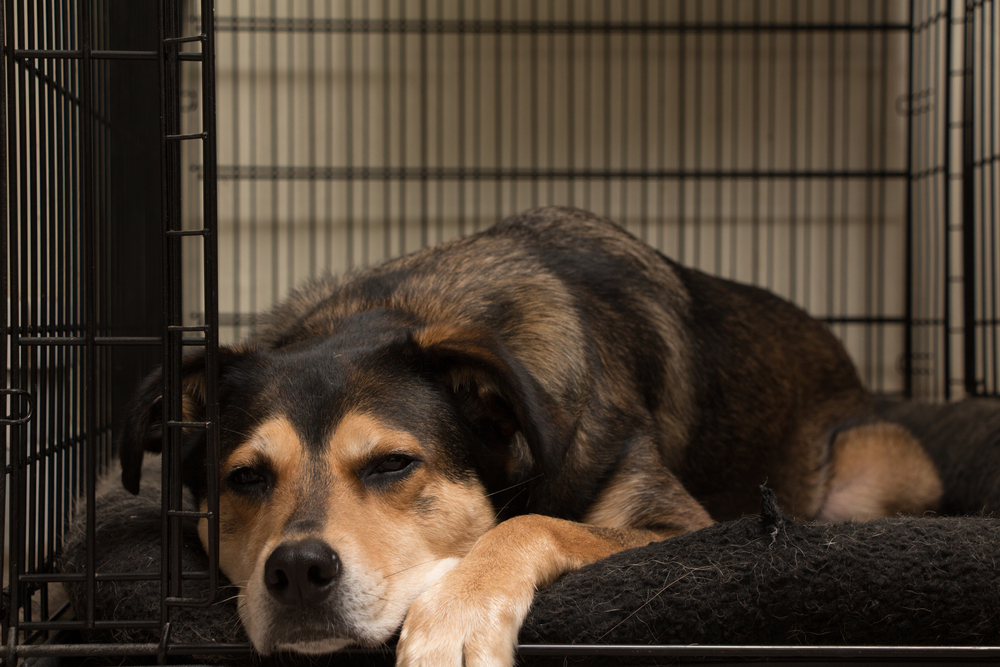Crate training is one of the most beneficial things we can do for our dogs, but before we can start that process we must first choose an appropriate crate for our dogs. For new dog owners especially, this initial step can be quite daunting and confusing, especially if they’ve got a puppy who is still growing.
Many owners may think that “bigger is better”, but that might not be the case when it comes to a dog crate. So can a dog crate be too big?
Dog crates can be too big depending on the dog and their individual needs. Having too big of a crate can lead to potty training issues for puppies, create handling issues for dogs with behavioral problems, and can interfere with illness or injury recovery in certain dogs.
In the article below, we’ll discuss specific situations in which a bigger crate might be more problematic than beneficial to a dog, and what to consider before purchasing a bigger crate for your pup.
Can A Dog Crate Be Too Big?
While we generally want our pups to have as much space as possible in their crate, it IS possible to have a crate that is too big. Most owners are concerned about a crate being too small, but a crate that is too large can also create issues for their dogs and household.
Dog trainer, Zoie Keast adds that “Your dog should be able to stand up fully, turn all the way around, and lay back down at a minimum.”
Issues With A Dog Crate That Is Too Big?
Here are several situations in which a crate might be too big for your dog or living situation, including the following:
Potty Training
If you are currently in the midst of house-training your pup, having a crate that is too big can actually cause setbacks in the potty-training process. Dogs don’t generally like to go to the bathroom where they sleep, but if your crate is disproportionately larger than the size of your puppy, they can go potty at one end of the crate and still feel comfortable on the other side of the crate.
Not A Bully’s advising veterinarian Dr. Georgina Ushi Phillips explains that the ideal dog crate size is one based on the dog’s current height and length, with about 4-5 inches added to both height and length to make the crate big enough for the dog to comfortably turn around and stretch out in.
So, you should get a crate for your puppy that matches their current size and be mindful of “graduating” them to larger crates as they age. This is a big reason why so many dog crates have “puppy dividers” that come with the crate and can be moved out as the dog gets bigger.
While we may think that more space is better in a dog crate, it can actually teach your puppy bad potty habits, potentially causing a regression with crate training and long-term issues with pottying in inappropriate places.
Illness Or Injury Recovery
Having too large a crate while your pup is recovering from an illness or injury might impact how much movement they make. In many cases, limited movement is required for dogs on crate rest to help aid their recovery.
If the crate is much larger than the dog, then it may allow them to pace or move around more than they should, which can cause issues with their treatment or recovery. This is especially true if they are recovering from an orthopedic injury or surgery, or if they are recovering from heartworm disease treatment.
Veterinarian Dr. Nita Patel told us, “With surgical recovery and exercise restriction, it is imperative that strict cage rest discharge instructions are followed to avoid any reinjury, delays in recovery, or improper healing.”
Behavioral Issues
While this depends greatly on the individual dog and the behaviors present, if your dog has a behavioral issue, such as extreme anxiety, obsessive compulsive behaviors, or other destructive behaviors, Dr. Patel tells us they may feel safer in slightly smaller spaces, as most dogs typically would, compared to having a crate that is much larger which could make those behaviors worse.
Crate pacing is a good example of this concept and can be a sign of an anxious dog or one who struggles with obsessive compulsive behaviors (though I want to stress that crate pacing can also be attributed to many other things). If the crate allows the dog too much room, they are more likely to pace up and down, up and down, up and down…on and on!
If placed in a crate that is just the right size for the dog to be comfortable but doesn’t allow them to engage in those unwanted behaviors, then the more likely it is they won’t attempt those behaviors.
However, as I explain to owners, just having a smaller crate size is unlikely to fix the root cause of the behavioral issue (and may encourage other unwanted behaviors in its place), so it’s a good idea to work with a trainer to help address your dog’s behaviors.
Crate Environment
A larger crate obviously takes up more space in your home, and can also be more difficult to move around, transport, or clean. If you live in an apartment, a larger crate could take up a significant portion of your living space, so choosing a crate that is smaller but still safe and comfortable for your dog is a good idea.
A larger crate can also be more time consuming to clean, especially if you have a smaller dog and they have a larger area to make a bigger mess in. For extremely large crates, if your dog has an “explosion”, it’s almost impossible to clean them inside and they must be taken outside to be hosed down and cleaned. Instead, if you had a smaller crate (one more suitable to your dog’s size), you might be able to clean it in the bathtub, shower, or by hand washing with rags and cleaner.
If your crate is not foldable or on wheels, it can also be more difficult to move the crate around. Of course, this information would not apply if you have a large or giant breed of dog, where a larger crate is necessary, but if you have a small or medium sized dog choosing a crate that is best suited for their size can save you a lot of household headaches.
Difficult To Handle Puppies Or Fearful Dogs
With puppies (especially those during the critical socialization period), being able to get them out of their crate quickly is ideal. You may need to remove them quickly to let them go potty, if you see them chewing on something they shouldn’t be, or in an emergency.
With a crate that is unnecessarily large for the puppy’s size, they have more of an opportunity to avoid you if they feel scared, threatened, or think you are playing a game. While some puppies can be enticed out of the crate fairly easily, others may cower in the corner, and you will have to reach in and gently guide them out.
This is also true of dogs who are fearful or anxious. A larger crate may be a good idea for some of those dogs, but for others, it can create issues like being unable to handle the dog (or getting them to even leave the crate), especially in an emergency.
Many of these dogs want to avoid being touched or grabbed by a person, so they’ll move as far away as possible. If you attempt to reach in and forcefully try to remove them (or in some extreme cases even if you just stick a limb in to try and lure them out with a treat), the dog may become even more terrified and may resort to more dangerous behavior such as a bite.
While a dog can still do these things in a smaller crate, I find it a little bit easier to coax them out by tossing treats just out of reach at the open door, gradually encouraging the dog to leave the crate.
This is difficult to do in a bigger crate housing a smaller dog because fearful dogs tend to try and be as far away from where you are as possible, and the safety of being in the back of the crate might outweigh their interest in being lured out.
Closing Thoughts
While we may want to provide our four-legged friends with as much space as possible in their crates, that might not always be the best idea depending on the individual dog.
For puppies and dogs going through the potty training and/or crate training process, having too big a crate can actually cause setbacks in that process.
Dogs who are suffering from behavioral issues, who are recovering from medical issues, or who are difficult to handle may also benefit from a crate that is sized just right for them rather than being too large.
While choosing the appropriate sized crate for your pup and his individual needs can feel a bit like Goldilocks and The Three Bears, with proper understanding of a dog’s needs you’ll be able to find the crate that is sized just right!




